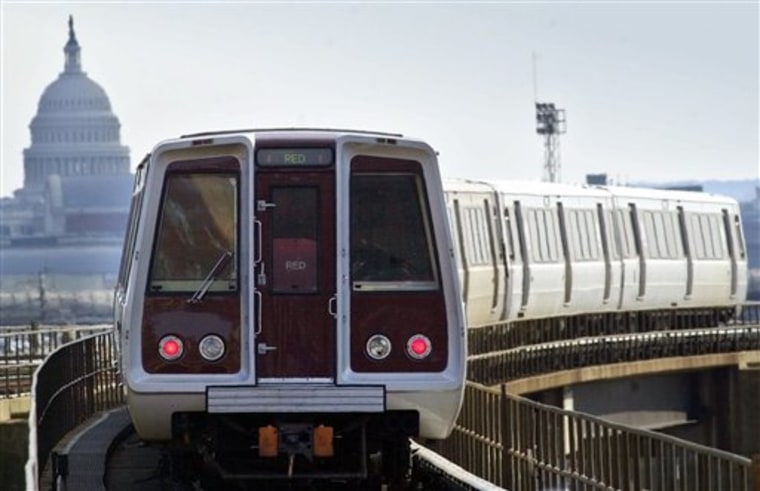It's the government's idea of a really bad day: Washington's Metro trains shut down. Seaport computers in New York go dark. Bloggers reveal locations of railcars with hazardous materials. Airport control towers are disrupted in Philadelphia and Chicago. Overseas, a mysterious liquid is found on London's subway.
And that's just for starters.
Those incidents were among dozens of detailed, mock disasters confronting officials rapid-fire in the U.S. government's biggest-ever "Cyber Storm" war game, according to hundreds of pages of heavily censored files obtained by The Associated Press. The Homeland Security Department ran the exercise to test the nation's hacker defenses, with help from the State Department, Pentagon, Justice Department, CIA, National Security Agency and others.
The laundry list of fictional catastrophes — which include hundreds of people on "No Fly" lists suddenly arriving at airport ticket counters — is significant because it suggests what kind of real-world trouble keeps the White House awake at night. Railway switches failed. Planes flew too close to the White House. Water utilities in Los Angeles were compromised.
Imagined villains include hackers, bloggers and even reporters. After mock electronic attacks overwhelmed computers at the Port Authority of New York and New Jersey, an unspecified "major news network" airing reports about the attackers refused to reveal its sources to the government. Other simulated reporters were duped into spreading "believable but misleading" information that worsened fallout by confusing the public and financial markets, according to the government's files.
The $3 million, invitation-only war game simulated what the U.S. described as plausible attacks over five days in February 2006 against the technology industry, transportation lines and energy utilities by anti-globalization hackers. The government is organizing another multimillion-dollar war game, Cyber Storm 2, to take place in early March.
The upcoming exercise in March will simulate electronic attacks against chemical plants and communication lines, and include targets in California, Colorado, Delaware, Illinois, Michigan, North Carolina, Pennsylvania, Texas and Virginia.
"They point out where your expectations of your capabilities may be overstated," Homeland Security Secretary Michael Chertoff told the AP. "They may reveal to you things you haven't thought about. It's a good way of testing that you're going to do the job the way you think you were. It's the difference between doing drills and doing a scrimmage."
The AP obtained the Cyber Storm internal records nearly two years after it requested them under the Freedom of Information Act. The government censored most of the 328 pages it turned over, marked "For Official Use Only," citing rules preventing the disclosure of sensitive information. The government is still reviewing hundreds of additional documents before they are turned over to the AP.
"Definitely a challenging scenario," said Scott C. Algeier, who runs a cyber-defense group for leading technology companies, the Information Technology Information Sharing and Analysis Center.
For the participants — including government officials from the United States, England, Canada, Australia and New Zealand and executives from leading technology and transportation companies — the mock disasters came fast and furious: Hacker break-ins at an airline; stolen commercial software blueprints; problems with satellite navigation systems; trouble with police radios in Montana; school closures in Washington, Miami and New York; computer failures at border checkpoints.
The incidents were divided among categories: computer attacks, physical attacks or psychological operations.
"We want to stress these players," said Jeffrey Wright, the former Cyber Storm director for the Homeland Security Department. "None of the players took 100 percent of the correct, right actions. If they had, we wouldn't have done our job as planners."
How did they do? Reviews were mixed. Companies and governments worked successfully in some cases.
But key players didn't understand the role of the premier U.S. organization responsible for fending off major cyber attacks, called the National Cyber Response Coordination Group, and it didn't have enough technical experts.
The sheer number of mock attacks complicated defensive efforts.
The little-known Cyber Response group, headed by the departments of Justice and Homeland Security, represents the largest U.S. government departments — including law enforcement and intelligence agencies — and is the principal organization for responding to cyber attacks and recovering from them.
The exercise had no impact on the real Internet. Officials said they were careful to simulate attacks using only isolated computers, working from basement offices at the Secret Service's headquarters in downtown Washington.
However, the government's files hint at a tantalizing mystery: In the middle of the war game, someone quietly attacked the very computers used to conduct the exercise. Perplexed organizers traced the incident to overzealous players and sent everyone an urgent e-mail marked "IMPORTANT!" reminding them not to probe or attack the game computers.
"Any time you get a group of (information technology) experts together, there's always a desire, 'Let's show them what we can do,'" said George Foresman, a former senior Homeland Security official who oversaw Cyber Storm. "Whether its intent was embarrassment or a prank, we had to temper the enthusiasm of the players."
